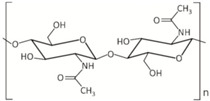Table 1.
Biomaterial passport: chitin.
| Scientific Name | Chitin |
|---|---|
| Chemical formula, MW, chemical structure, polymorphism |

|
| (C8H13O5N)n; MW ranges from several to thousands of kDa [12]. Chitin is a linear polymer of N-acetyl-d-glucosamine units that are linked by 1,4-β-glycosidic bonds [13]. It exists in three crystalline polymorphic forms: α-, β-and γ-chitin [14,15]. Marine sources of α-chitin: crustaceans, sponges; of β-chitin: cephalopods [16]. | |
| Physicochemical properties | Due to its semicrystalline structure and hydrophobicity chitin is not soluble in usual solvents, i.e., water, the most organic solvents, though it shows solubility in hexafluoroacetone sesquihydrate, hexafluoroisopropanol, chloroalcohols (with sulfuric acid), mixture of dimethylacetamide with 5% lithium chloride [17] and diverse ionic liqiuds [18]. |
| Chitin extraction/Physical form after extraction | For commercial purposes, chitin is extracted using chemical, electrochemical and biochemical methods from the cuticles of crustaceans, mostly crabs and shripms [19,20,21,22,23,24] and corals [25]. It is isolated by chemical extraction via three stages, i.e., deproteinization by alkaline treatment, i.e., employing NaOH, Na2CO3, NaHCO3, KOH, K2CO3, demineralization using acidic (i.e., HCl, HNO3, H2SO4, CH3COOH), or EDTA-based solutions [26], and finally discoloration following the incubation in alkaline solution or by the addition of acetone or, alternatively, using KMnO4, H2O2 [27] or oxalic acid [12,28]. Currently, numerous studies aimed at developing different protocols to isolate chitin from seafood shells [29,30,31,32,33,34] as well as marine sponges [35] have been reported. Chitin is extracted in the form of flakes, powders, and scaffolds. |
| Biomaterials properties (biocompatibility, biodegradability, toxicity, immune responses) | Elastic (Young’s) modulus ranges from 92 GPa [36] to 4 GPa [37]. Thermostability: 260–360 °C [38,39,40]. Biocompatible [1,41,42,43] and biodegradable [12]; can be hydrolyzed by chitinases [44]; non-toxic and [45] of low immunogenicity [46,47]. |
| Market situation (world market reports) | According to Global Industry Analysts, Inc. data, global chitin and chitosan market was predicted to reach US $4.2 billion by 2021 [12]. |
| Patents | Currently, about several hundreds of patents on the extraction and modification of chitin and its derivatives as well as their applications exist. |
| For search, use: https://patents.google.com/ | |
| Selected examples: | |
| US6310188B1. Method for producing chitin or chitosan | |
| US6632941B2. Method of extracting chitin from the shells of exoskeletal animals | |
| CN106496362A. The extracting method of chitin in a kind of Carapax Eriocheir sinensis | |
| US20180186899A1. Compositions of partially deacetylated chitin derivatives | |
| JP2822174B2. Method for producing chitin chitosan fiber and structure | |
| US5623064A. Poly-β-1→-4-N-acetylglucosamine | |
| US9433698B2. High strength chitin composite material and method of making | |
| US9708634B2. Process for making chitin derivatives | |
| US7241463B2. Methods for processing crustacean material | |
| US4066735A. Process for demineralization of crustacea shells | |
| US4293098A. Recovery of active chitin and enhanced protein meal | |
| WO1986006082A1. A process for recovering chitin from materials in which chitin occurs together with or connected to proteinaceous substances | |
| US5053113A. Method of chitin production from chitin containing raw materials | |
| JPH05310804A. Production of chitin or chitosan from integument of crustacea |
